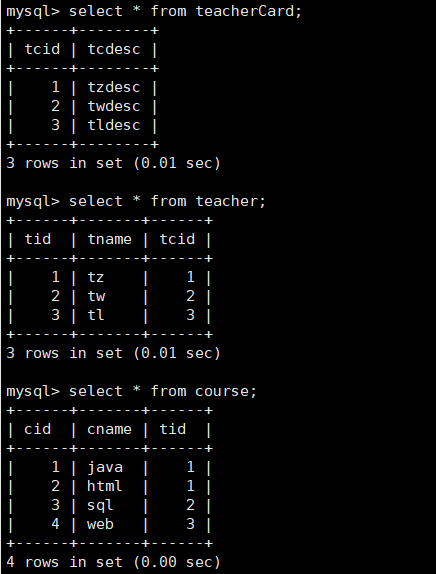MySql版本:5.5
SQL性能问题
a.分析SQL的执行计划 : explain ,可以模拟SQL优化器执行SQL语句,从而让开发人员 知道自己编写的SQL状况
b.MySQL查询优化其会干扰我们的优化
优化方法,参考官网:MySql 5.5 优化
查询执行计划: explain +SQL语句
例表:teacher 、teacheCard 、course

分析SQL的执行计划

字段说明:
(1)id值不同:id值越大越优先查询 (本质:在嵌套子查询时,先查内层 再查外层)
查询教授SQL课程的老师的描述(desc)
explain select tc.tcdesc from teacherCard tc,course c,teacher t where c.tid = t.tid
and t.tcid = tc.tcid and c.cname = 'sql' ;
将以上 多表查询 转为子查询形式:
explain select tc.tcdesc from teacherCard tc where tc.tcid =
(select t.tcid from teacher t where t.tid =
(select c.tid from course c where c.cname = 'sql')
);
子查询+多表:
explain select t.tname ,tc.tcdesc from teacher t,teacherCard tc where t.tcid= tc.tcid
and t.tid = (select c.tid from course c where cname = 'sql') ;
id值有相同,又有不同: id值越大越优先;id值相同,从上往下 顺序执行
(2)select_type:查询类型
PRIMARY: 包含子查询SQL中的 主查询 (最外层) SUBQUERY:包含子查询SQL中的 子查询 (非最外层) simple: 简单查询 (不包含子查询、union) derived: 衍生查询 (使用到了临时表) a.在from子查询中只有一张表 explain select cr.cname from ( select * from course where tid in (1,2) ) cr ; b.在from子查询中, 如果有table1 union table2 ,则table1 就是derived,table2就是union explain select cr.cname from ( select * from course where tid = 1 union select * from course where tid = 2 ) cr ; union:上例 union result :告知开发人员,那些表之间存在union查询
(3)type:索引类型、类型
system>const>eq_ref>ref>range>index>all ,要对type进行优化的前提:有索引
其中:system,const只是理想情况;实际能达到 ref>range
system(忽略): 只有一条数据的系统表 ;或 衍生表只有一条数据的主查询
eq_ref:唯一性索引:对于每个索引键的查询,返回匹配唯一行数据(有且只有1个,不能多 、不能0)
ref:非唯一性索引,对于每个索引键的查询,返回匹配的所有行(0,多)
range:检索指定范围的行 ,where后面是一个范围查询(between ,> < >=, 特殊:in有时候会失效 ,从而转为 无索引all)
index:查询全部索引中数据
all:查询全部表中的数据
create table test01 ( tid int(3), tname varchar(20) ); insert into test01 values(1,'a') ; commit; 增加索引 alter table test01 add constraint tid_pk primary key(tid) ; explain select * from (select * from test01 )t where tid =1 ; const:仅仅能查到一条数据的SQL ,用于Primary key 或unique索引 (类型 与索引类型有关) explain select tid from test01 where tid =1 ; alter table test01 drop primary key ; create index test01_index on test01(tid) ; eq_ref:唯一性索引:对于每个索引键的查询,返回匹配唯一行数据(有且只有1个,不能多 、不能0) select ... from ..where name = ... .常见于唯一索引 和主键索引。 alter table teacherCard add constraint pk_tcid primary key(tcid); alter table teacher add constraint uk_tcid unique index(tcid) ; explain select t.tcid from teacher t,teacherCard tc where t.tcid = tc.tcid ; 以上SQL,用到的索引是 t.tcid,即teacher表中的tcid字段; 如果teacher表的数据个数 和 连接查询的数据个数一致(都是3条数据),则有可能满足eq_ref级别;否则无法满足。 ref:非唯一性索引,对于每个索引键的查询,返回匹配的所有行(0,多) 准备数据: insert into teacher values(4,'tz',4) ; insert into teacherCard values(4,'tz222'); 测试: alter table teacher add index index_name (tname) ; explain select * from teacher where tname = 'tz'; range:检索指定范围的行 ,where后面是一个范围查询(between ,> < >=, 特殊:in有时候会失效 ,从而转为 无索引all) alter table teacher add index tid_index (tid) ; explain select t.* from teacher t where t.tid in (1,2) ; explain select t.* from teacher t where t.tid <3 ; index:查询全部索引中数据 explain select tid from teacher ; --tid 是索引, 只需要扫描索引表,不需要所有表中的所有数据 all:查询全部表中的数据 explain select cid from course ; --cid不是索引,需要全表所有,即需要所有表中的所有数据
归纳:
system/const: 结果只有一条数据
eq_ref:结果多条;但是每条数据是唯一的 ;
ref:结果多条; 但是每条数据是是0或多条 ;
(4)possible_keys :可能用到的索引,是一种预测,不准。
alter table course add index cname_index (cname);
explain select t.tname ,tc.tcdesc from teacher t,teacherCard tc
where t.tcid= tc.tcid
and t.tid = (select c.tid from course c where cname = 'sql') ;
(5) key :实际使用到的索引
如果 possible_key/key是NULL,则说明没用索引
(6)key_len :索引的长度
作用:用于判断复合索引是否被完全使用 (a,b,c)。
create table test_kl ( name char(20) not null default '' ); alter table test_kl add index index_name(name) ; explain select * from test_kl where name ='' ; -- key_len :60 在utf8:1个字符站3个字节 alter table test_kl add column name1 char(20) ; --name1可以为null alter table test_kl add index index_name1(name1) ; explain select * from test_kl where name1 ='' ; --如果索引字段可以为Null,则会使用1个字节用于标识。 drop index index_name on test_kl ; drop index index_name1 on test_kl ; 增加一个复合索引 alter table test_kl add index name_name1_index (name,name1) ; explain select * from test_kl where name1 = '' ; --121 explain select * from test_kl where name = '' ; --60 varchar(20) alter table test_kl add column name2 varchar(20) ; --可以为Null alter table test_kl add index name2_index (name2) ; explain select * from test_kl where name2 = '' ; --63 20*3=60 + 1(null) +2(用2个字节 标识可变长度) =63 utf8:1个字符3个字节 gbk:1个字符2个字节 latin:1个字符1个字节
(7) ref : 注意与type中的ref值区分。
作用: 指明当前表所 参照的 字段。
alter table course add index tid_index (tid) ;
explain select * from course c,teacher t where c.tid = t.tid and t.tname ='tw' ;
(8)rows: 被索引优化查询的 数据个数 (实际通过索引而查询到的 数据个数)
explain select * from course c,teacher t where c.tid = t.tid
and t.tname = 'tz' ;
(9)Extra:
(i).using filesort : 性能消耗大;需要“额外”的一次排序(查询) 。常见于 order by 语句中。
排序:先查询
10个人 根据年龄排序。
create table test02
(
a1 char(3),
a2 char(3),
a3 char(3),
index idx_a1(a1),
index idx_a2(a2),
index idx_a3(a3)
);
explain select * from test02 where a1 ='' order by a1 ;
a1:姓名 a2:年龄
explain select * from test02 where a1 ='' order by a2 ; --using filesort
小结:对于单索引, 如果排序和查找是同一个字段,则不会出现using filesort;如果排序和查找不是同一个字段,则会出现using filesort;
避免: where哪些字段,就order by那些字段2
复合索引:不能跨列(最佳左前缀)
drop index idx_a1 on test02;
drop index idx_a2 on test02;
drop index idx_a3 on test02;
alter table test02 add index idx_a1_a2_a3 (a1,a2,a3) ;
explain select *from test02 where a1='' order by a3 ; --using filesort
explain select *from test02 where a2='' order by a3 ; --using filesort
explain select *from test02 where a1='' order by a2 ;
explain select *from test02 where a2='' order by a1 ; --using filesort
小结:避免: where和order by 按照复合索引的顺序使用,不要跨列或无序使用。
(ii). using temporary:性能损耗大 ,用到了临时表。一般出现在group by 语句中。
explain select a1 from test02 where a1 in ('1','2','3') group by a1 ;
explain select a1 from test02 where a1 in ('1','2','3') group by a2 ; --using temporary
避免:查询那些列,就根据那些列 group by .
(iii). using index :性能提升; 索引覆盖(覆盖索引)。原因:不读取原文件,只从索引文件中获取数据 (不需要回表查询)
只要使用到的列 全部都在索引中,就是索引覆盖using index
例如:test02表中有一个复合索引(a1,a2,a3)
explain select a1,a2 from test02 where a1='' or a2= '' ; --using index
drop index idx_a1_a2_a3 on test02;
alter table test02 add index idx_a1_a2(a1,a2) ;
explain select a1,a3 from test02 where a1='' or a3= '' ;
如果用到了索引覆盖(using index时),会对 possible_keys和key造成影响:
a.如果没有where,则索引只出现在key中;
b.如果有where,则索引 出现在key和possible_keys中。
explain select a1,a2 from test02 where a1='' or a2= '' ;
explain select a1,a2 from test02 ;
(iii).using where (需要回表查询)
假设age是索引列
但查询语句select age,name from ...where age =...,此语句中必须回原表查Name,因此会显示using where.
explain select a1,a3 from test02 where a3 = '' ; --a3需要回原表查询
(iv). impossible where : where子句永远为false
explain select * from test02 where a1='x' and a1='y' ;
 explain 分析SQL的执行计划
explain 分析SQL的执行计划 恭喜注册成功,快来登录吧!
恭喜注册成功,快来登录吧!